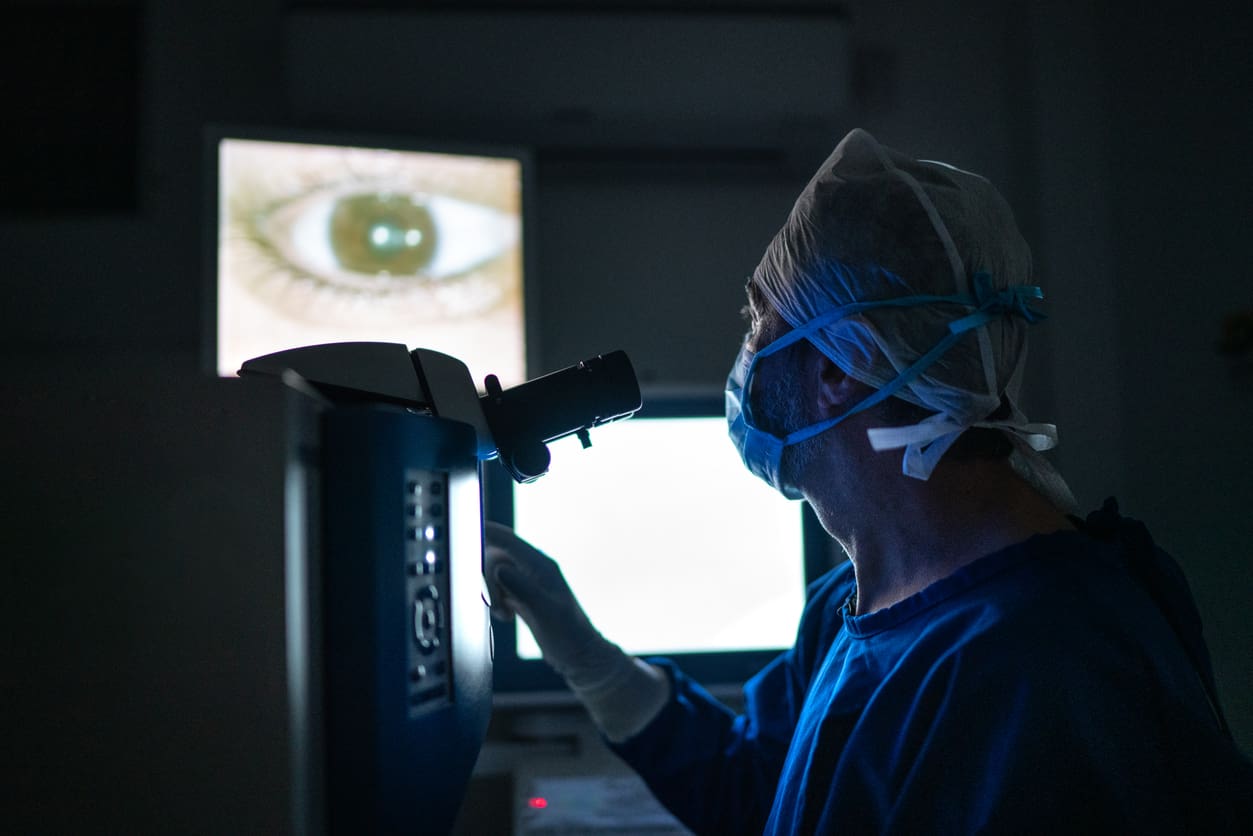Cataract Surgery
Cloudy vision holding you back? Our advanced cataract surgery, featuring laser-assisted technology and lifestyle lenses, can restore your sight and help you enjoy life’s moments clearly again. Book a consultation and learn about the right care for your specific needs.

Table of Contents
What is Cataract Surgery?
Cataract surgery is a medical procedure where the cloudy natural lens of the eye, known as a cataract, is removed and replaced with an artificial intraocular lens (IOL). This lens is designed to restore your vision and allow light to properly focus on the retina, enabling clear and sharp sight. Most cataracts are age-related, although other types of cataracts exist.
When cataracts develop as part of the natural aging process, they go through four stages of progression. Surgery is required once the cataract is advanced enough that it interferes with daily activities and glasses no longer help. Your doctor will evaluate your cataract and tell you if you are ready for surgery.
Despite its significant impact, cataract surgery is a relatively short outpatient procedure, which requires around 10-20 minutes to complete. In the majority of cases, patients can return home the same day, with minimal disruption to their daily routines.
Cataract Treatment Basics
While there is no “cure” for cataracts, vision can be improved by removing your eye’s natural lens and implanting an intraocular lens (IOL) in its place. This synthetic lens can help focus light in a way similar to your natural lens, allowing you to see much more clearly. Because your cloudy lens is removed and the new lens is synthetic, you cannot develop cataracts again in that same eye.
There are no ways to “dissolve” cataracts at home, and any products claiming to do so are falsely advertised. This is true of both human cataracts and those in animals.
Who Is an Ideal Candidate?
Cataracts are a progressive condition, usually worsening over time. In the early stages of cataracts, their effect on vision may be minimal or even nonexistent.
As cataracts progress, they can interfere with daily activities, making tasks like reading or driving increasingly difficult. When simple measures such as using reading glasses or adjusting lighting no longer provide adequate relief, surgery may be considered.
Your doctor will help you determine the optimal timing for the procedure, taking into account the cataract’s progression and its impact on your daily functioning. The decision to undergo surgery is a collaborative one, balancing the potential benefits of improved vision against any possible risks or complications.
How Effective Is Cataract Surgery?
Cataract surgery is highly effective, with approximately 99% of patients achieving 20/40 vision or better, enabling activities like driving without glasses. The procedure can correct various vision conditions, including myopia, hyperopia, presbyopia, and astigmatism, using appropriate intraocular lens (IOL) implants. Benefits extend beyond improved vision, encompassing enhanced quality of life, increased independence, and reduced risk of falls.
However, there are potential drawbacks to consider. While basic lens options are typically covered by insurance, advanced IOLs that correct multiple vision issues may incur additional out-of-pocket expenses. Some patients may experience temporary side effects such as dry eyes or light sensitivity. In rare cases, complications like infection or retinal detachment can occur.
Despite these considerations, the overwhelming majority of patients report high satisfaction with their improved vision and overall quality of life following cataract surgery.
Types of Cataract Surgery
There are three types of cataract surgery: phacoemulsification, extracapsular cataract extraction (ECCE) and femtosecond-laser assisted cataract surgery (FLACS). As the first tech-assisted procedure on the market, phacoemulsification is the most common surgery available, but FLACS is now considered the most precise with fastest recovery.
Femtosecond laser-assisted cataract surgery (FLACS)
Femtosecond laser-assisted cataract surgery (FLACS) is a newer and more advanced technique that incorporates laser technology to perform several steps of cataract surgery, including the capsulotomy (the opening of the lens capsule) and the lens fragmentation. The femtosecond laser provides a higher degree of precision and consistency, which ensures optimal removal of the cataract and the most accurate placement of the IOL. This is particularly beneficial for patients with premium IOLs, as these advanced lenses require very precise placement.
Phacoemulsification
Phacoemulsification is the most common type of cataract surgery, as it was the first approach to introduce more precise technology for cataract removal and IOL placement. During this procedure, your surgeon uses a small incision to remove the clouded lens and replace it with an artificial intraocular lens (IOL). The surgeon then uses a tiny ultrasonic probe to break up and suction out the cataract, leaving behind the clear capsule that originally surrounded the lens. The new IOL is then inserted into this capsule.
Extracapsular cataract extraction (ECCE)
ECCE, also known as manual cataract surgery, is a more traditional approach to cataract removal. During ECCE, the surgeon makes a larger incision to remove the entire lens in one piece, leaving the capsule (the thin, transparent membrane that surrounds the lens of the eye) in place. The artificial IOL is then inserted into the capsule. While no longer the standard approach, this method is sometimes recommended when the cataract is particularly dense or in certain high-risk cases. While ECCE is still a safe and effective procedure, it typically has a longer recovery time than phacoemulsification and FLACS.
Cataract Surgery at NVISION
NVISION Centers use the latest technology to deliver the best cataract surgery experience to our patients, and to ensure the best possible visual outcomes. Besides using the femtosecond laser to assist in critical parts of the surgery, we were the first to incorporate the ORA® System (Optiwave Refractive Analysis) to get the most accurate measurements of your eye.
What is the ORA® System?
The ORA® System technology measures how light waves are distorted as they pass through the eye’s optical system, which includes the cornea and crystalline lens. It provides highly precise measurements of the optical imperfections in the eye and of the eye’s refractive power.
ORA® provides real-time measurements of the patient’s eye during surgery, adding a critical layer of assurance and accuracy to the entire process. With a database of 2 million real-world cases, ORA® allows surgeons to validate your IOL choice by analyzing your eye measurement and comparing it to global trends.The tool also provides critical insights to make adjustments to the IOL power and placement, ensuring the best possible outcomes after your cataract surgery.
Intraocular Lenses: Choosing the Right IOL
When choosing an IOL for cataract surgery, you have to consider your lifestyle and vision correction needs. Talk to your cataract surgeon about your IOL options. Ask them the pros and cons of each choice, and discuss what you hope to get out of your surgery. You and your surgeon will decide on the choice that makes the most sense for you.
MONOFOCAL LENSES
Monofocal lenses are the most common type of IOL used in cataract surgery, and they are covered by insurance. These basic lenses focus light at one distance, usually far. You will need to wear glasses after surgery to be able to see close objects clearly.
TORIC IOLS
Toric lenses are designed to correct astigmatism. They are curved to match the shape of the eye and are used to correct irregularities in the cornea. Toric lenses can be monofocal, but most premium lenses include a toric alternative.
LIFESTYLE LENSES
Lifestyle lenses, also known as premium lenses, are designed to provide a broader range of clear vision and are often used for patients who want to reduce their dependence on glasses or contacts. These premium lens options come in different types:
multifocal iols
Multifocal lenses are designed to correct both near and far vision. They have multiple focal points, allowing patients to see clearly at different distances without needing glasses. Although several models of multifocal IOLs are available, two of the most popular options are the PanOptix Trifocal and AcrySof IQ Vivity Extended Vision IOLs developed by Alcon.
accommodating iols
Accommodating lenses are designed to move with the eye to focus on different distances. They are suitable for patients who want to reduce their dependence on glasses for both near and far vision.
light-adjustable lenses
Light-adjustable lenses are designed to be adjusted after surgery to fine-tune the patient’s vision. They are made of a special material that can be adjusted using special laser technology.
Client Testimonial
“Now, I read without glasses and I can bead without glasses.”

Getting Ready for Surgery
Once you know what type of surgery you want and which IOL is the right fit for you, the next step is preparing for surgery. This includes scheduling pre-operative appointments, such as a comprehensive eye exam and medical history review, to ensure you are in optimal health for surgery.
In the days leading up to the procedure, you will receive detailed instructions from your surgeon on how to prepare, which may include guidelines on medication adjustments, fasting requirements, and any necessary lifestyle modifications. Your doctor will also explain how the procedure works and what recovery will be like afterwards.
Knowing what to expect before, during and after surgery is essential for minimizing risks, optimizing surgical outcomes, and ensuring you feel confident and informed on the day of your cataract procedure.
Free in-depth consultation
Our experienced team will conduct a comprehensive eye exam to determine whether your cataract is ready for surgery and what type of IOL is best for your eye and lifestyle needs.
10 to 20 minute outpatient procedure
Cataract surgery is quick, painless and highly effective. Most patients notice significant improvement the day after surgery.
Resume normal activities after 1 to 3 days
Get back to your normal routine in just a few days, avoiding strenuous activities and activities that stress the eyes. Follow the instructions of your doctor for a speedy recovery.
Cataract Surgery at NVISION
At NVISION, we specialize in laser-assisted cataract surgery, delivering enhanced vision results to our patients. This method involves using a femtosecond laser to make precise incisions and soften the cataract before it is removed, ensuring a smooth procedure.
Laser-assisted cataract surgery uses 3D mapping and imaging to develop a more complete view of the patient’s eye. This high level of precision ensures the ideal placement of your intraocular lens implant, resulting in a perfect match.
What You Should Know About Cataracts
Having cataracts can be like looking through a frosty or fogged-up window, making daily activities difficult. It is the clouding of the eye’s natural lens, a transparent structure in the eye that helps refract light on the back of the retina. The lens is made of protein and water, but when the proteins clump together a cataract is formed.

Insurance & Financing
Paying with Insurance
Cataract surgery coverage can depend on if it is medically necessary or elective. Some providers may offer discounts or special rates for Cataracts, depending on the specifics of your plan. If you choose a premium lens with additional features (like multifocal or toric lenses), you may need to pay extra out-of-pocket, as insurance often only covers standard lenses. It’s always a good idea to check with your insurance provider to understand the benefits available to you.
VSP and Cataract Surgery
NVISION stands out as a partner of VSP, offering substantial benefits to VSP members that are seldom matched elsewhere. Through this collaboration with VSP, NVISION frequently provides exclusive VSP discounts on Cataracts procedures, making the transformative journey towards clearer vision more accessible and affordable.
Frequently Asked Questions
IS SURGERY THE ONLY OPTION FOR CATARACT REMOVAL?
Cataract surgery is a medically necessary procedure. However, there are many surgical options for removing a cataract. Your NVISION surgeon will explain the options available to you and help you choose which solution is best for your needs. In most cases, laser-assisted cataract surgery is the preferred option, as it offers enhanced precision for cataract removal and implant placement.
IS THERE A SOLUTION FOR PATIENTS WITH VISION CONDITIONS AND CATARACTS?
Patients who also have other vision conditions can gain vision improvement with the implantation of intraocular lenses.
Vision conditions such as myopia (nearsightedness), hyperopia (farsightedness), presbyopia (the inability to focus close-up), and/or astigmatism (a misshapen cornea causing blurry or ghost-like images) are all treatable with intraocular lenses.
Cataract surgery can also be combined with PRK or LASIK to fine-tune the results.
WHAT ARE THE RISKS AND SIDE EFFECTS OF CATARACT SURGERY?
Cataract surgery is one of the most commonly performed and successful surgical procedures in modern medicine. Approximately 99% of patients report improved vision following the procedure.
Cataract surgery, like any eye surgery, carries certain risks such as infection, inflammation, and bleeding. However, these complications are rare and typically manageable when promptly reported to your doctor.
A common complication is the development of haze behind the new artificial lens, which can mimic cataract symptoms. This condition is called Posterior Capsule Opacification, and it is easily treated with a YAG laser capsulotomy to restore clear vision.
After cataract surgery, your eye’s lens can no longer adjust like a natural lens. If you choose a basic lens implant, you will have to wear glasses to see near objects clearly. With premium lens options, this can be corrected. While not equivalent to a natural lens, these options offer a broader range of vision.
Visual perception may temporarily change after surgery, making everything appear brighter. This adjustment period may require sunglasses until your eyes adapt. Some patients may experience increased light sensitivity or worsened dry eye, though these symptoms are usually manageable and will go away in time.
HOW LONG WILL MY IOL LAST?
Intraocular lenses (IOLs) implanted during cataract surgery are designed to be permanent and typically last a lifetime. Once implanted, they do not degrade or wear out over time. Therefore, unless there are complications or specific reasons for replacement (such as refractive errors or other eye conditions), the IOL should continue to provide clear vision indefinitely.
HOW MUCH IS CATARACT SURGERY?
Out of pocket cost for basic cataract surgery is estimated to be about $2-3,000 per eye if there is no insurance coverage. Multifocal, astigmatism correcting and other specialty IOLs are an added expense, as is the use of laser assisted cataract surgery and other advanced technologies your surgeon may recommend for you.
Health insurance, including Medicare, covers the cost of basic cataract surgery, provided the impairment from the cataract interferes with daily life. This coverage includes only the single vision lens implant.
Why Choose NVISION for Your Cataract Surgery?
Our Experience
Our board-certified surgeons are the most experienced, educated and caring professionals in the eye care industry. Our surgeons have performed over 2,500,000 procedures. More eye doctors have had their surgery performed by an NVISION surgeon than any other provider of eye care.
Patient Care
Every NVISION patient is different, and therefore, we strive to personalize their treatment based on their unique needs. We treat every patient with care, compassion, empathy and professionalism with a promise to deliver the best-in-class patient care for cataract surgery and any other vision procedure.
Technology
We utilize only the most advanced laser and diagnostic equipment available to ensure we can deliver the best outcomes for our patients. We offer a wide range of IOL options to our patients, ensuring they can get the best vision outcomes for their personal needs.

Book Your Consultation
You're one step closer to life without glasses or contacts. Just answer a few quick questions about your eye exam, and we'll lock in your appointment.
Have a question? Give our experts a call!
877-455-9942